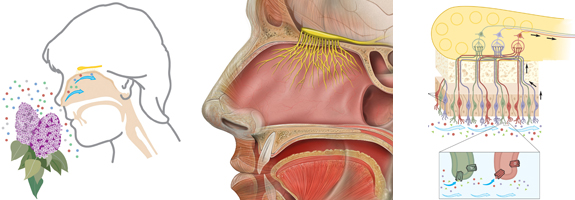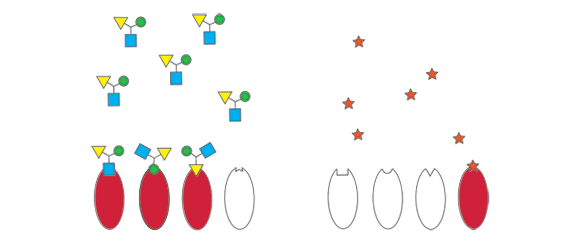Clues into how the brain might solve these problems are found in research exploring how the nose detects chemical odorants. Nearly twenty years ago Linda Buck and Richard Axel, in a spectacular series of experiments, identified specific molecules — odorant receptors — that detect the presence of volatile odorants in the air. We now know that there are more than 1000 odorant receptor genes in the genome of a typical mammal like a mouse, a kind of molecular testimony to the importance of the sense of smell. These genes are expressed in olfactory sensory neurons housed within the nose, and it is these neurons that are responsible for telling the brain about the presence of odors in the environment. They do so via filamentous branches called axons, which cross the nasal cavity, thread through holes in the cribriform plate of the skull, and then terminate in a brain structure called the olfactory bulb. Medical students often claim that there are “no olfactory emergencies”; tell that to the occasional pugilist who takes a hard punch to the nose and cracks his cribriform plate, thereby severing his olfactory sensory neuron axons and instantly losing his ability to smell.

Even at the level of the nose itself, before information even enters the brain, it is likely that molecular features of the odorant receptors plays a role in organizing information about smells. As mentioned above there are about 1000 odorant receptors in a typical vertebrate genome, although somewhat more in macro-osmates with particularly acute senses of smell, like bloodhounds. This clutch of odorant receptors enables vertebrates to detect and discriminate perhaps as many as 100,000 different odors. Because the number of detectable odors far exceeds the number of receptors, by necessity there cannot be a unique receptor for each odor. Instead a large body of evidence suggests that individual odors are identified through the unique combination of receptors that are activated — and with more than 1000 receptors encoded in the genome, there are more potential combinations than there are particles in the universe. Receptors that participate in this process are “generalists,” and any given generalist receptor binds to (and tells the brain about) a wide range of odorants.

Thus no single receptor alone tells the brain what the nose is smelling; instead the unique combination of receptors activated by particular smells allows the brain to identify odors. But embedded within this system are a number of “specialist” receptors, whose structure has been carefully honed by evolution to specifically recognize odors of particular importance to the organism. Specialist receptors detect these critical odors and then trigger specific innate behaviors. The mosquito, for example, expresses a receptor specific for a component of human sweat, enabling the mosquito to seek out its preferred food source. Other specialist receptors have been found that enable fruit flies to escape from elevated levels of carbon dioxide, or that afford moths the ability to detect pheromones critical for appopriate sexual interactions. There even is a specialist receptor that tells zebrafish when other fish sense danger in the environment, thereby plugging zebrafish into a kind of water-borne alarm system. Although none have been characterized in any detail, it is likely that specialist receptors also exist in mammals to drive specific categories of innate behavior.
